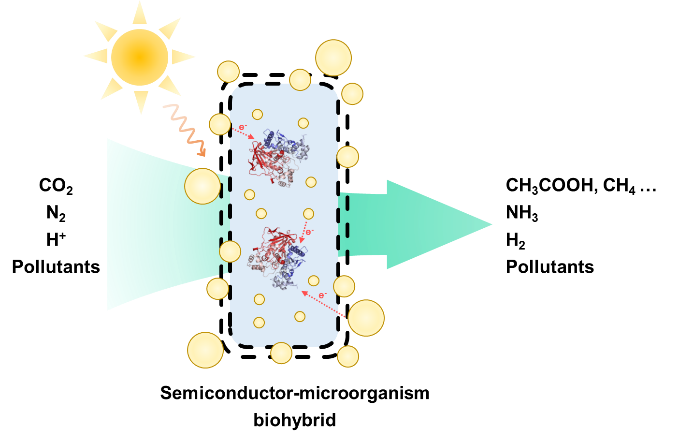 PDF(16700 KB)
PDF(16700 KB)


Photo-Driven Whole-Cell Biohybrids Based on Semiconductors and Microorganisms
Kaichong Wang, Han Wang, Yayi Wang
Prog Chem ›› 2025, Vol. 37 ›› Issue (2) : 157-172.
 PDF(16700 KB)
PDF(16700 KB)
 PDF(16700 KB)
PDF(16700 KB)
Photo-Driven Whole-Cell Biohybrids Based on Semiconductors and Microorganisms
Solar energy is the energy source for all life on Earth, and its efficient conversion is of great significance for solving the global energy crises and environmental issues. Inspired by natural photosynthesis, researchers have recently developed whole-cell biohybrids based on semiconductors and microorganisms by integrating the excellent light absorption ability of photosensitizer semiconductors and the efficient biocatalysis ability of whole-cell microbes. The development of whole-cell biohybrids aims to realize efficient solar-to-chemical production in a green and low-carbon pathway. This review clarifies the operation principle and advantages of whole-cell biohybrids, and the properties of photosensitizer semiconductors are summarized, including the band structure, excitation wavelength and quantum yield. Moreover, this work innovatively concludes the construction mechanisms of whole-cell biohybrids and the electron transfer mechanisms in the interface between semiconductor and microbe. Moreover, the advanced progress of whole-cell biohybrids are reviewed, such as the high-value conversion of carbon dioxide, artificial nitrogen fixation, hydrogen production as well as pollutant removal and recovery. Finally, the environmental impacts and challenges of whole-cell biohybrids are discussed and the perspectives for the development of whole-cell biohybrids are proposed. This article is expected to provide fundamental insights for the further development and actual application of whole-cell biohybrids.
1 Introduction
2 Principles and advantages of whole-cell biohybrids
3 Types of photosensitizers in whole-cell biohybrids
3.1 Inorganic semiconductors
3.2 Organic semiconductors
4 Construction mechanisms of whole-cell biohybrids
5 Advanced application progresses of whole-cell biohybrids
5.1 High-value conversion of CO2
5.2 Artificial nitrogen fixation
5.3 Hydrogen production
5.4 Pollutants removal and resource recovery
6 The environmental impacts and challenges in whole-cell biohybrids
7 Conclusion and outlook

solar energy / semiconductor / microorganism / whole-cell biohybrid / electron transport
| [1] |
|
| [2] |
|
| [3] |
|
| [4] |
|
| [5] |
|
| [6] |
|
| [7] |
|
| [8] |
(鲁安怀, 王鑫, 李艳, 丁竑瑞, 王长秋, 曾翠平, 郝瑞霞, 杨晓雪. 中国科学: 地球科学, 2014, 44(6): 1117.)
|
| [9] |
|
| [10] |
|
| [11] |
|
| [12] |
|
| [13] |
|
| [14] |
|
| [15] |
|
| [16] |
(张德善, 佟振合, 吴骊珠. 化学进展, 2022, 34(7): 1590.)
|
| [17] |
|
| [18] |
|
| [19] |
|
| [20] |
|
| [21] |
(胡安东, 周顺桂, 叶捷. 化学进展, 2021, 33(11): 2103.)
|
| [22] |
|
| [23] |
|
| [24] |
|
| [25] |
|
| [26] |
|
| [27] |
|
| [28] |
|
| [29] |
|
| [30] |
|
| [31] |
|
| [32] |
|
| [33] |
|
| [34] |
|
| [35] |
(吴丹. 华东师范大学博士论文, 2022.)
|
| [36] |
|
| [37] |
|
| [38] |
|
| [39] |
|
| [40] |
|
| [41] |
|
| [42] |
|
| [43] |
|
| [44] |
|
| [45] |
|
| [46] |
|
| [47] |
|
| [48] |
|
| [49] |
|
| [50] |
|
| [51] |
|
| [52] |
|
| [53] |
|
| [54] |
|
| [55] |
|
| [56] |
(刘礼兵, 周鑫, 白昊天, 黄一鸣, 吕凤婷, 王树. 中国科学: 化学, 2022, 52(2): 241.)
|
| [57] |
|
| [58] |
|
| [59] |
|
| [60] |
|
| [61] |
|
| [62] |
|
| [63] |
|
| [64] |
|
| [65] |
|
| [66] |
|
| [67] |
|
| [68] |
|
| [69] |
|
| [70] |
|
| [71] |
|
| [72] |
|
| [73] |
|
| [74] |
García de Arquer F P,
|
| [75] |
|
| [76] |
|
| [77] |
|
| [78] |
|
| [79] |
|
| [80] |
|
| [81] |
|
| [82] |
|
| [83] |
|
| [84] |
|
| [85] |
|
| [86] |
|
| [87] |
|
| [88] |
|
| [89] |
|
| [90] |
Editorial. Nat. Synth, 2023, 2(7): 581.
|
| [91] |
|
| [92] |
|
| [93] |
|
| [94] |
|
| [95] |
|
| [96] |
|
| [97] |
|
| [98] |
|
| [99] |
|
| [100] |
|
| [101] |
|
| [102] |
|
| [103] |
|
| [104] |
|
| [105] |
|
| [106] |
|
| [107] |
|
| [108] |
|
| [109] |
|
| [110] |
|
| [111] |
|
| [112] |
|
| [113] |
|
| [114] |
|
| [115] |
|
| [116] |
|
| [117] |
|
| [118] |
|
| [119] |
|
| [120] |
|
| [121] |
|
| [122] |
|
| [123] |
|
| [124] |
|
/
| 〈 |
|
〉 |